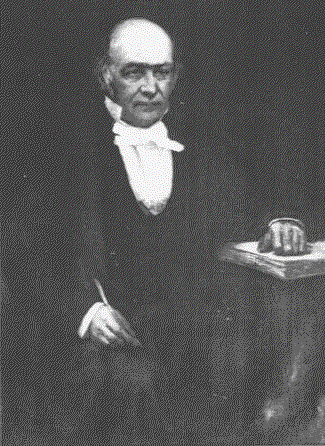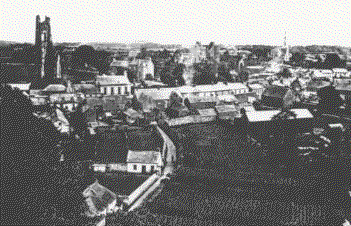

(1805 - 1865)
Born in Dominick Street, Dublin in 1805, William Rowan Hamilton grew up to become one of the greatest mathematicians of all time. Even at the beginning of his career, he was regarded by many as a future second Newton. By the age of thirty, he was knighted for all the scientific work he had achieved.
His family conscious of their son's early promise, sent him to live in Trim with his uncle, when he was three years old. His uncle the Reverend James Hamilton, was an honours graduate in Classics of Trinity College , Dublin, and a bit of an eccentric. He had his own ideas on education; for instance he made a hole in the wall of his bedroom and ran a string through it, the end of which was tied to Hamilton's toe. Then, early each morning he would tug on the string to wake young Hamilton and start him on his studies.
Trim, Co.Meath,
where William spent most of his childhood.

By the age of five, Hamilton had learned Hebrew, Greek and Latin. So advanced were his linguistic skills, that by the age of 13, he was familiar with 13 languages, including Persian, Syriac and Arabic. His interest in mathematics was sparked by the arrival of a young American prodigy Zenith Colburn to Ireland, who he fought in many duals of arithmetic. By the age of 15, he was studying the works of Newton and Laplace .
In 1823, at the age of 18, he entered Trinity College, Dublin, where he excelled in maths and physics. Just before he had completed his time here, he was appointed Professor of Astronomy and Royal Astronomer of Ireland at Dunsink Laboratory. He was only 22.
Trinity College, Dublin,
where William went to College in 1823.

The academic field was by no means his only interest. Broad-chested and of medium size, he was strong and active in gymnastics and swimming. He also had interests in reading literature and poetry. It was through his love of both, literature and poetry that he met the writer Maria Edgeworth (1768-1849) and William Wordsworth (1770-1850). He met Wordsworth for the first time while on holiday in Scotland. They became good friends and frequent correspondents. Wordsworth became a major influence in Hamilton's life, often cautioning him against wearing rose-coloured spectacles in affairs of the heart. Hamilton devoted a lot of time to poetry, and constantly sought a link between the higher levels of science and poetry. Wordsworth feared that Hamilton would concentrate his efforts on poetry, and generally seems to have felt it his duty to steer Hamilton away from poetry, telling him his talents lay in science.
Hamilton had a fascinating personality. He was described by friends as having "a buoyant cheerfulness and a kindly human-heartedness" and was legendary for his great courtesy and amiability. Women invariably found him charming and apparently attractive because of his obvious intelligence.
In many ways Hamilton embodied the layman's image of the absent-minded scientist. He was usually late for appointments and happily thought that he could always explain himself to the average listener. However, evidence suggests that as a lecturer, he was not a great success. When lecturing, he had the habit of following whatever stray idea came into his head, and so it is doubtful whether his students gained much from his lectures.
Although an intellectual genius, the study, of this great mind that sought to bring new order to the Universe, was one of complete dis-order. The room where this intellectual genius worked on his many theories was indeed the typical organised mess but to a onlooker it more resembled a pigsty; awash with papers, and yet he could always tell if anyone had disturbed its order, even slightly.
Sometimes even the most learned scholar can unwittingly possess a total ignorance of common sense in everyday matters, as is obvious when Hamilton and his sisters were temporarily snowed in, in Dunsink, without any bread. Hamilton cheerfully proposed that they make their own bread from sawdust in accordance with the latest scientific recipe. Neither this nor the idea of "snow" pancakes was thankfully graciously received.
Dunsink Observatory
during the Hamilton years.

On August 17, 1824, on a visit to the Langford estate at Summerhill, Co.Meath, Hamilton first met Catherine Disney, whom in the end proved to be the only woman he ever really loved.He became totally and devastatingly infatuated with Catherine, and she also with him. However it seems, her parents became alarmed at the prospect of their daughter marrying a poor undergraduate and arranged for her to make a more "suitable" match with a Reverend Barlow, from a well off legal family. The memory of Catherine, his lost love, haunted him throughout his life, as is evident through the many poems he wrote about her. On 9th April, 1833, he married Helen Bayly, selecting a wife who would become a semi-invalid, suffering from ill-defined nervous complaints through out her life.

Photograph of Brougham Bridge and plaque.
Hamilton loved to walk, in the country or along the canal when he was reading or doing some serious thinking. It was on such an occasion that his most famous discovery of Quaternions was made. On Monday Oct 16th, 1943, when he was walking along the Royal Canal with his wife, the idea of Quaternions came to him, in a dramatic flash of inspiration. In his excitement he carved the formula in the stone of Brougham Bridge. This can still be seen today.

Drawing of Brougham Bridge on the Royal Canal, where Hamilton inscribed the famous formula for his Quaternions.
Quaternions opened up a vast new field of mathematics. However many mathematicians at the time found them too difficult to use. William Thomson ,for e.g. said he could never find any instance in which they were superior to existing methods. However, today they are the basis of computer graphics.
In 1834, he published "General methods in Dynamics " which was to be the most important of all his mathematical discoveries. This mathematical method, which allows light to be treated as waves or particles equally, virtually predicted modern wave mechanics. Atomic fission and laser beams are just some of the modern developments that are grounded in this same maths.
Hamilton also predicted the unexpected phenomenon of Conical Refraction in biaxial crystals, which served to immediately highlight his name, and won him the Royal medal of the Royal Society, in 1835. Michael Faraday (1791-1867), was the other recipient of the medal that year. He also invented the Icosian Game, based on the mathematics of graph theory.
The Icosian Game and
diagram.

Hamilton's later life was unhappy. The death of his sister and friend Wordworth and an unhappy marriage resulted in troubled times for Hamilton. After two years of abstaintion, he became addicted to alcohol. In 1865, he died from a severe attack of gout.
Today there is a Crater Hamilton on the moon, in memory of this great mathematician.
Here is one of the many sonnets Hamilton wrote, as he approached Ireland in a paddle-steamer from England.
" My native land, appear! these eyes
await
Impatiently thy rising over the bare
Expanse of waters; fondly searching where
Thy fair but hidden form lingers so late..
In thee my homeward thoughts still claim their share,
My hear, my life, to thee are
dedicate."